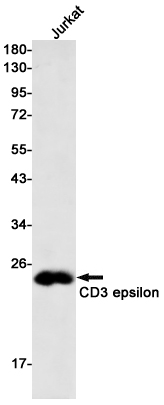-
Product Name
Anti-CD3 epsilon Rabbit antibody
- Documents
-
Description
CD3 epsilon Rabbit monoclonal antibody
-
Tested applications
WB, FC, IP
-
Species reactivity
Human
-
Alternative names
T3E; TCRE; IMD18 antibody
-
Isotype
Rabbit IgG
-
Preparation
Antigen: A synthetic peptide of human CD3 epsilon
-
Clonality
Monoclonal
-
Formulation
50nM Tris-Glycine(pH 7.4), 0.15M Nacl, 40%Glycerol, 0.01% sodium azide and 0.05% BSA.
-
Storage instructions
Store at 4°C short term. Store at -20°C long term. Avoid freeze / thaw cycle.
-
Applications
WB: 1/2000-1/10000
FC: 1/20-1/100
IP: 1/20
-
Validations

Western blot detection of CD3 epsilon in Jurkat cell lysates using CD3 epsilon Rabbit mAb(1:500 diluted).Predicted band size:23kDa.Observed band size:23kDa.
-
Background
Swiss-Prot Acc.P07766.Part of the TCR-CD3 complex present on T-lymphocyte cell surface that plays an essential role in adaptive immune response. When antigen presenting cells (APCs) activate T-cell receptor (TCR), TCR-mediated signals are transmitted across the cell membrane by the CD3 chains CD3D, CD3E, CD3G and CD3Z. All CD3 chains contain immunoreceptor tyrosine-based activation motifs (ITAMs) in their cytoplasmic domain. Upon TCR engagement, these motifs become phosphorylated by Src family protein tyrosine kinases LCK and FYN, resulting in the activation of downstream signaling pathways (PubMed:2470098). In addition of this role of signal transduction in T-cell activation, CD3E plays an essential role in correct T-cell development. Initiates the TCR-CD3 complex assembly by forming the two heterodimers CD3D/CD3E and CD3G/CD3E. Participates also in internalization and cell surface down-regulation of TCR-CD3 complexes via endocytosis sequences present in CD3E cytosolic region (PubMed:10384095, PubMed:26507128).
Related Products / Services
Please note: All products are "FOR RESEARCH USE ONLY AND ARE NOT INTENDED FOR DIAGNOSTIC OR THERAPEUTIC USE"
